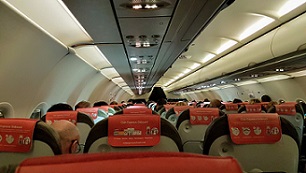 Lithium-ion batteries. Photo by Simon Gough on free photo website Pexels.
Lithium-ion batteries. Photo by Simon Gough on free photo website Pexels.
 All these everyday personal electronic devices are powered by lithium-ion batteries
All these everyday personal electronic devices are powered by lithium-ion batteries
 The confined space of a passenger airline cabin is the last place you’d want a lithium battery fire
The confined space of a passenger airline cabin is the last place you’d want a lithium battery fire
 A pilot with an AvSax lithium battery fire mitigation bag
A pilot with an AvSax lithium battery fire mitigation bag
Fires caused by lithium batteries overheating or even exploding are regularly reported in the media caused by a process called thermal runaway … but what exactly is thermal runaway?
Well, we’ll have a go here at explaining thermal runaway the simplest way we can even though it’s caused by a complex chemical reaction inside the lithium-ion battery.
In short, thermal runaway is an uncontrollable chain reaction in a battery which gives off immense heat, toxic smoke and sometimes enough power to make it explode.
And, as lithium batteries are used to power all our modern personal electronic devices such as mobile phones, laptops and iPads, when they explode they will send shrapnel flying in all directions.
That’s why thermal runaway incidents are particularly dangerous on passenger aircraft and why more than 100 airline companies worldwide now carry AvSax (www.avsax.com) lithium battery thermal fire mitigation bags to deal with an emergency on board. They have been used in action for dozens of incidents, instantly preventing potentially catastrophic damage to the passengers and planes.
But what is thermal runaway and why does thermal runaway happen?
One side of a lithium-ion battery is a cathode and the other is an anode with a separator inbetween.
Both side have lithium-ions which are released from the cathode when the battery is charging and then released from the anode when the battery is being used and is discharging.
This flow is helped by a liquid called electrolyte and there is a membrane called a separator to prevent the flow of anodes between the two sides.
There are 3 stages in the thermal runaway process.
Stage 1: The battery begins to overheat which could be caused by the device being damaged – perhaps crushed in an airline seat – overcharged with a cheap charger that doesn’t meet safety standards or has simply been left in direct sunlight.
Stage 2: The critical factor now is that the separator melts exposing the anode to the cathode. The temperature quickly rises and the lithium reacts with solvents in the electrolyte releasing flammable hydrocarbon gases which include methane. Oxygen begins to build up inside the battery.
Stage 3: The intense heat and the oxygen sparks the flammable electrolytes which can cause fires or explosions.
The temperatures generated by thermal runaway are incredibly high – up to 900°C (1652°F) – which cause a lithium battery fire to flare repeatedly and they are very difficult to put out. This is why they need to be continually cooled as they can flare up at any time and give off toxic gases.
When it comes to airline safety this is why AvSax is the world’s most widely-used lithium battery fire mitigation bag by far and every time it has been used the aircraft was able to continue safely to its destination with no need to divert or make an emergency landing. Each diversion can cost airlines hundreds of thousands of dollars.
The reason AvSax are so effective and are the main choice for airlines is that these thermal containment bags are designed to continually cool the overheating battery using water poured into the bag.
This use of liquid is recommended by the Civil Aviation Authority (CAA) in the UK and many other fire containment bags don’t work this way.
In its guidance the CAA states: "Since the development of the International Civil Aviation Organization (ICAO) guidance on dealing with an in-flight battery fire, new products designed for use in response to lithium battery thermal runaway events have become available.
"Products which provide both a cooling and containment capability are typically more aligned to the existing ICAO guidance as when used they are filled with water or other non-flammable liquid to act as a cooling agent.
"After knocking down flames it could conceivably take just a couple of seconds for a personal electronic device to be placed inside a containment bag, allowing it to be moved to a place of safety. Passengers could then return to their seats, mitigating potential unrelated safety hazards such as injury in the case of severe turbulence. Equally, the effect on flight crew in carrying out their duties following an event on the flight deck would be minimised."
AvSax were devised by Environmental Defence Systems Ltd based in Huddersfield, West Yorkshire, England and the company won the Queen’s Award for Enterprise for their innovation in the UK – the top accolade any business can get.